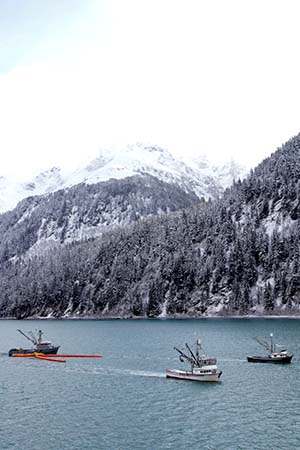By JEREMY ROBIDA
Council Project Manager
On March 15 and 16, Alyeska’s Ship Escort Response Vessel System, known as SERVS, conducted an oil spill response training in Cordova.
A total of 27 vessels were involved, including Cordova-based vessels, three Valdez fishing vessels, the nearshore support barge known as the “500-2,” and its accompanying tug. Many of the vessels spent the night on scene as part of the training, with exercise activities taking place during daylight hours in Nelson Bay, a small, protected bay approximately five miles from Cordova.
Equipment and tactics used included a mix of nearshore oil recovery and sensitive area protection strategies. Responders had a chance to work with the equipment to determine which systems worked best for their vessels and crews. Vessel tasks varied each day to keep responders engaged and to provide a wider range of training.
Protection of sensitive areas
Sensitive area protection has recently been given greater emphasis following changes to the Prince William Sound Tanker Contingency Plan, commonly called a “C-Plan”, in 2012. The 2012 C-Plan identifies special sensitive area task forces that get out ahead of a slick to protect areas that are most vulnerable. Many such sensitive areas have already been pre-identified such as hatcheries or wetlands. Following these changes to the 2012 C-Plan, SERVS annual fishing vessel training has increased its focus and training on sensitive area protection tactics and gear.
Participants practiced nearshore protection tactics
Specialized oil containment boom called “shoreseal” is sometimes used in conjunction with standard boom to protect beaches, using an “exclusion” response tactic. Exclusion tactics are used to keep oil away from shorelines.
The shoreseal boom is a three chamber type boom with two lower chambers and an upper chamber. The lower two chambers are filled with water to weigh the boom down and cause it to seal itself against the shoreline at low tide. The upper chamber is filled with air and as the tide moves in and out, this air chamber provides enough float to lift the shoreseal above water, but still seal it against land at low tide.
Two sections of shoreseal are connected to either end of a section of the standard boom. The standard boom, in the middle, is stretched and anchored offshore and the shoreseal boom is attached to land, creating a “U” shape. The open part of the “U” is on the land side of the beach.
This type of exclusion tactic can be used around the mouth of a salmon stream, for example, or a regularly visited public use area to keep oil from reaching the shore.
Lessons learned

Overall, the training went well. A few responders noticed missing small parts, such as floats for hoses and instruction manuals which should be easily addressed. A few small maintenance issues also came to light. One section of shoreseal boom had a small hole in the upper air chamber. A bad decanting pump was also discovered. Response gear obviously needs to be response ready and one value of this training was to highlight these maintenance issues so that SERVS can better work to prevent future problems. Some lessons focused on the reality of the training scenario. A small SERVS’ landing craft was used extensively to support sensitive area protection beach operations. Two of these craft are stored aboard the 500-2. Since sensitive area protection teams are expected to work well ahead of the main slick and would therefore likely be some distance from the 500-2, it was is recommended that the use of these 500-2 based vessels in future sensitive area protection trainings be validated as representative of the types of vessels that would be available.